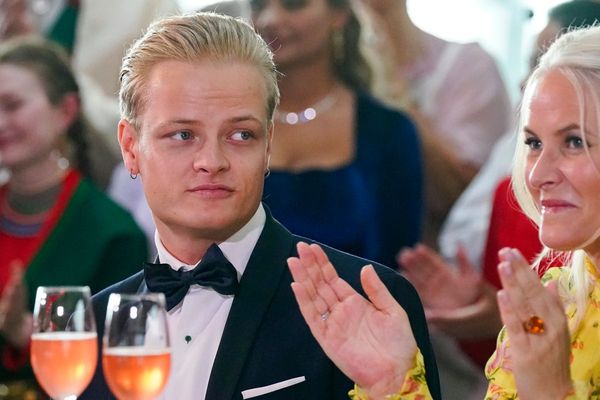As director Walter Hill was writing the screenplay for “Dead For A Dollar,” he looked to the past. But his inspiration was a much older past than the Old West tales of cowboys and cattle drives or lawmen and desperados that have played across movie screens since the dawn of Hollywood.
“I started out with an idea that I wanted to do something – this sounds self-aggrandizing – but I wanted to do something in a classic framework,” says Hill, 80, whose films as a writer, director or producer have included the likes of “The Getaway,” “The Warriors,” “48 Hours” and “Alien: Covenant.”
“So I fell back again — I’ve used it several times — on the kind of Homeric idea of ‘corrupt power figure hires a professional warrior to bring back a wife who seems to have been abducted, but turns out not to be true,’” he says. “I had that in my head, to borrow from Homer.”
What further triggered his imagination, though, was a real-life character he discovered while researching his tale.
“Chris Madsen was born in Denmark,” Hill says. “He was a soldier as a young man in the Danish Army. He fought in the Prussian War in 1864. He then left Denmark.”
After a stint in the French Foreign Legion in North Africa, Madsen sailed to New York City, headed West, joined the U.S. Army, and then made the decision that led to Hill’s particular interest in him.
“He got out of the Army, became a lawman and a bounty man,” Hill says. “And I thought, ‘Well, boy, you know this is a good idea because all the bounty men we’ve ever seen in movies are always these big, fairly silent Anglo types.
“I thought it would be very refreshing maybe to try to develop the idea around somebody with a reasonably sophisticated European sensibility.”
In “Dead For A Dollar,” which arrives in theaters Sept. 30, Austrian German actor Christoph Waltz plays bounty hunter Max Borlund, who is hired to track down Rachel Price, the allegedly abducted wife played by Rachel Brosnahan.
Willem Dafoe co-stars as Joe Cribbens, an ex-con with a grudge against Borlund, and Benjamin Bratt plays Tiberio Vargas, the Mexican outlaw who controls the barren territories where all the players eventually come together.
“It just kind of fell together,” Hill says of the story and the cast. “It’s not a big movie in scope. I shot it in 25 days, and there was little money to spend. But no complaints; there was enough.
“The story got told, and so, I don’t know, here we are.”
An elegant simplicity
“Dead For A Dollar” returns Hill to a genre he’s worked in throughout his career with films such as “The Long Riders” and “Geronimo: An American Legend,” and TV work such as the miniseries Emmy-winning “Broken Trail.”
But his love for Westerns reaches all the way back to his boyhood as a cowboy movie-crazy kid growing up in Long Beach.
“My brother and I used to go every weekend and we would see the first-run features in a neighborhood theater not far from us,” Hill says. “And then there was another theater, the Circle, old and rundown, on Flower Street.
“They would show on Sunday double- and triple-features of B-movie Westerns,” he says. “Johnny Mack Brown or Wild Bill Elliott or those kinds of films. And I loved it.”
Hill eventually outgrew the low-budget, formulaic flicks at the Circle, though never the great works of the genre.
“I remember one of the great motion-picture experiences I’ve ever had was when, I guess I must have been, I don’t know, 11 years old or so, when I saw ‘Shane,’” Hill says. “I didn’t know anything could ever be better. It was so good. I mean, it’s a wonderful movie.”
As for the appeal of Westerns throughout the history of the movies?
“I’ve always admired the elegant simplicity of the storytelling which layers and almost disguises the really fundamental serious issues that they usually portray,” says Hill, whose new film includes subtexts of racism and feminism. “I mean, what makes a Western a Western? It’s not just location or even period.
“It’s the idea that people have to work out their problems in absence of a higher authority,” he says. “They can’t go to the Army or the government. The local constabulary is usually weak. They have to sort out whatever problem it is themselves.
“I’ve always said if you’re privileged to make a Western it’s not so much you’re walking around the world of 1875 or 1895 or something. You’re walking around in the Old Testament.
“They’re Old Testament stories and I like that.”
Character studies
Hill says he assembled his cast with surprising speed.
“I was friendly with Christoph Waltz,” he says of the actor who’s won a pair of Academy Awards, one of them coincidentally for playing a bounty hunter in “Django Unchained.” “So after I got a draft in shape, I sent him the script.
“You send actors scripts, sometimes you don’t hear for weeks,” Hill says. “I think it was one night later. He called and basically said, When do we start?”
Hill had directed Dafoe in 1984’s “Streets Of Fire.” They’d remained friends ever since, always talking about doing another film together but never quite making it happen.
“I thought he would be a perfect foil to Christoph,” Hill says. “I thought he was the right sensibility. And I wanted him to have a mixed character. He’s not simply a bad guy, as Christoph’s character is not simply a good guy.”
Rachel Brosnahan was a stranger to him, though he knew her Emmy Award-winning work in the title role of “The Marvelous Mrs. Maisel” as well as films such as the 2020 neo-noir “I’m Your Woman.”
As the shooting date approached, Hill still didn’t have a lead actress. Then the casting director told him she might be able to get Brosnahan to read the script.
“I said, God, do you think you could?” Hill says. “Do you think she’d be interested?”
He and Brosnahan talked on the phone for half an hour and she was in.
“I said, ‘Most women characters are looking for love. This woman is not looking for love; she’s looking for respect. She’s looking for her own self-dignity. And that’s what you have to play.”
Way out West
“Dead For A Dollar” was filmed about an hour outside of Santa Fe, New Mexico. The sparse beauty of the terrain gives the film a sense of isolation that underscores the Western’s mandate for self-sufficiency.
To make the New Mexico location look even more as he envisioned the sun-washed deserts of northern Mexico, where the characters all ultimately are drawn together, Hill shot the film in sepia tones and removed some of the natural scrub brush in postproduction.
Asked whether it’s rougher shooting a picture in such rugged terrain, he laughed.
“Actually, the reverse is true,” Hill says. “Westerns, if you can grab one to do, you’re out in the middle of nowhere. You’re in beautiful country. You’re with the horses, the wranglers, the cast, the crew. But you own it.
“You can shoot in any direction and you can just figure it out in pure filmmaking terms,” Hill says. “Where when you do a city movie you’re always fighting the parking and where are we going to park the equipment? City noise and traffic and we can’t shut down this street.
“You don’t have that kind of tension and pressure when you make a Western.”
Shooting showdowns
Hill’s movies have often been praised for their action sequences, and when the film’s showdown finally arrives, the sequence delivers on the promise that’s been brewing since the opening credits rolled.
“The first principle is you have to keep everybody within character,” Hill says of his philosophy of action filmmaking. “You’ve been telling this story for an hour and a half and you must not violate the characters. In other words, Max Borlund shouldn’t be leaping from rooftop to rooftop or something like that.
“He is a very capable man, and in the action sequence he knows it, but he stays within who he is,” he says.
The town and its geography also guide the action, and it’s important that it’s varied, too. While discussing the “very short and very intense” final battle, he discusses some elements of the ending — which are not included here — that could be considered spoilers though Hill sees it differently.
“The audience is rarely surprised,” he says about the familiar plot points of Westerns. “They can be entertained by how you do it. That’s the trick.”
Directors never quit
“Dead For A Dollar” is dedicated to director Budd Boetticher, whose late ’50s Westerns with actor Randolph Scott and writer Burt Kennedy are some of Hill’s favorites.
“I said to the film editor, ‘Budd Boetticher would have liked this movie,’” Hill says. “He said, ‘Why?’ and I said, ‘Because it’s kind of like one of his.’ This is throwing myself on the side of the gods, I realize.
“But I do think it’s true,” he says. “It deals with codes and ethical understandings and misunderstandings, which his films did in a marvelous way.”
Hill is currently at work on a pair of screenplays to direct. One is a 1970s noir about a saloon owner in New York City in the 1970s. The other is another Western about a real-life shooting and an all-star posse that he’s adapting from a book called “Thunder Over the Prairie.”
“As I feel good, might as well keep going,” Hill says. “Somebody will say to me, ‘When are you going to retire?’ – usually with a hopeful voice. I always say, ‘Directors don’t retire.’ I never knew one that did.
“You’re like a ballplayer. At a certain point, they come in and take away your uniform and you go home. But you usually don’t quit.”
———







